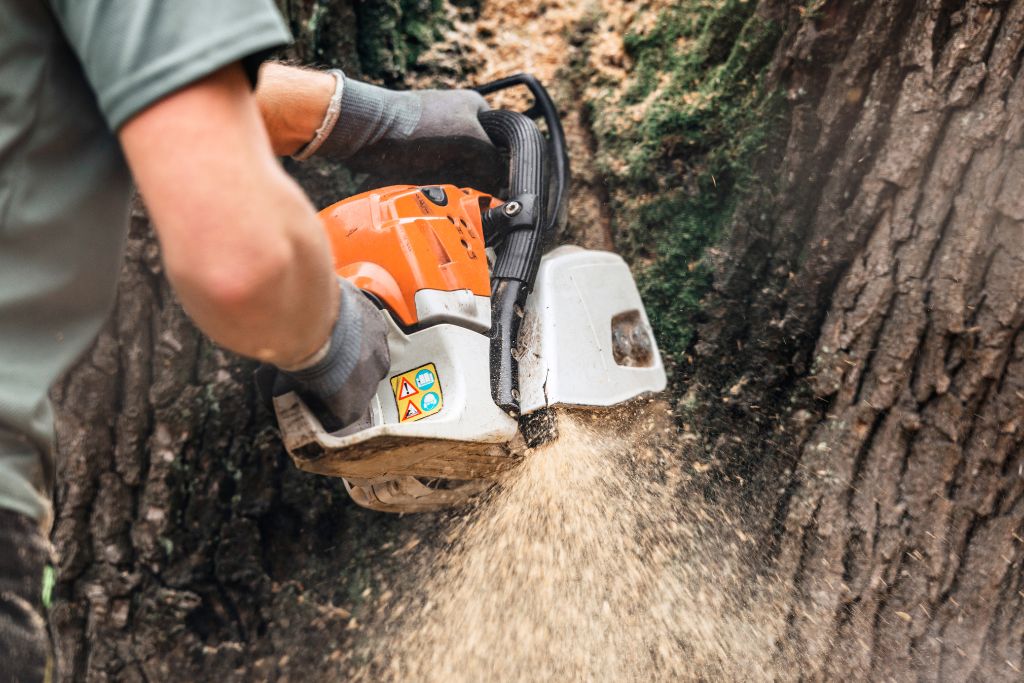Blog
Leave The Chainsaw Work To The Pros
When it comes to cutting down a dead or dying tree, removing large limbs from trees, or cutting a fallen tree into either firewood or small, easy to handle sections, no tool is more effective than a chainsaw.

A chainsaw can make short work of most pruning or tree removal jobs. We know; our professionals use them nearly every day. Nothing works better or is more effective.
But the same power, speed and cutting effectiveness that make chainsaws excellent tools for arborists also make them some of the most dangerous tools available to homeowners.
If you’re considering purchasing or renting a chainsaw for work on your property, consider the following:
- According to the Centers for Disease Control, more than 36,000 people are treated in U.S. emergency rooms annually for chainsaw injuries.
- Chainsaws are ranked the fifth most dangerous tool on the market today, behind table saws, ladders, nail guns and circular saws.
- The average number of stitches needed to treat a chainsaw injury is 110.
- Chainsaw injuries are in most cases caused by operator error. These errors are usually associated with ordinary actions on the part of the operator, including:
- Loss of footing while operating a chainsaw
- Loss of control of the saw while cutting above waist level
- Falling while carrying a running chainsaw
- Being struck by a falling limb or flying particles
- Reaching across a moving chain
- Touching and being burned by hot chainsaw components
- The most common chainsaw injuries are to the hands, lower legs and knees. Approximately 10 percent of chainsaw injuries involve the operator’s head. Each year, several chainsaw operators are injured or killed when a running chainsaw strikes their neck, often severing their carotid artery. Injuries to operators’ legs can involve the femoral artery.
- Chainsaw injuries among non-professionals have risen with the increased popularity of battery-powered chainsaws. Analysts believe this increase is attributable to the ease of starting electric chainsaws, which require little expertise or experience to start.
- Chainsaw injuries and deaths are so common in the U.S., that a number of law firms handle only chainsaw-related lawsuits.
Chainsaws Aren’t The Only Threat
In addition to the dangers posed by chainsaws, homeowners who prune or cut down trees face other significant dangers.
Falling limbs injure – sometimes fatally – do-it-yourselfers AND professional arborists. A diseased or dead tree limb can easily weigh several hundred pounds. That much weight falling on an unsuspecting person who doesn’t happen to be looking upward can be extremely dangerous.
Falling trees are a constant threat to amateurs and certified arborists. Trees don’t always fall in the direction or manner they’re “supposed to,” and can land on people or property. Wind can be a factor and so can tree trunks splitting in an unpredictable manner.
Recognize When It’s Time To Bring In A Professional
Don’t underestimate the inherent risks associated with chainsaws and tree care. This work is fraught with danger, even for experienced professionals. On average, two tree care professionals lose their lives every three days in on-the-job accidents in the U.S., making tree care work one of the most dangerous occupations in the country. As dangerous as chainsaws and tree care work are for professionals, amateurs with significantly less training and experience face even greater risks.
If you are uncertain as to your ability to safely operate a chainsaw or if you are not certain you can safely handle the tools needed for pruning and felling trees, reach out to Hansen’s Tree Service and let our insured, experienced professionals do the work for you. Your trees will benefit from professional care and most important you, your loved ones and your property will be safe.
Contact us today to schedule a tree risk assessment or services for your trees!
